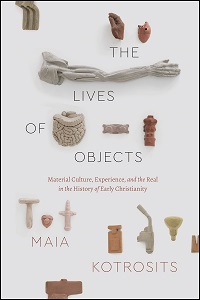by Daniel C. Smith
Maia Kotrosits, The Lives of Objects: Material Culture, Experience, and the Real in the History of Early Christianity (Chicago: University of Chicago Press: 2020; 230 pages; $30.00).
In her 2015 book, Rethinking Early Christian Identity: Affect, Violence, and Belonging (Fortress Press), Maia Kotrosits offered an incisive and timely corrective to a long-standing and powerful current in Ancient Christian Studies by suggesting that “identity” as a redescriptive category fails to glimpse the much more dynamic processes of attachment found in Early Christian literature. Five years later, her next monograph offers another timely reappraisal of material culture in the study of Ancient Mediterranean Religion. In The Lives of Objects, Kotrosits examines critically the fruits of the material turn in recent decades of Humanities, Religious Studies, and Ancient Mediterranean scholarship, challenging the field to expand “almost to the point of breakage” our ideas of “what we might take material culture to mean in the first place,” (21).

Kotrosits does not mean to dispense with the newfound interest in materiality and agency, but she is quick to remind us that these means of accessing the Ancient Mediterranean are not somehow more real or less bound up in scholarly desires and limitations: “this book approaches materiality—and what is implied by it—both critically and expansively. It destabilizes material objects as such, their ‘realness,’ mostly by noticing that their stability is a product of psychological work,” (2).
The introduction and chapter one lay the theoretical framework for the book, drawing on a constellation of Postructural, Postcolonial, Critical Race Theory, and—most centrally—Psychoanalytic luminaries to anchor the case studies to come. Kotrosits here lays out a central claim of the book, that objects, whether psychic objects of attachment or material objects, say something about how we construct “the real” and are able to glimpse it. Scholarly description, she argues, is a perilous pursuit, latent with desires for control and narcissism in the guise of self-reflexivity. Yet by attending to the power at work in this effort, we can attempt to get at something (if not quite “the real”) through descriptions that decenter dominant frames.
Chapters two and three deal with ruination and the loss of sovereignty as sites of belonging and collective-making. Describing Revelation’s Babylon as “always already fallen” (46) and Corinth’s Asklepieion as a site of social formation by means of collecting broken bodies, these chapters move from literary and material evidence to consider ruination and memorialization as attempts to address the loss of sovereignty. Chapters four and five, perhaps the richest contributions, consider Tertullian of Carthage, Martyrdom literature, and juridical scenes from the Roman Imperial period as archives of colonial subjects producing meaning, fantasizing about justice, and dealing with language within a violent empire. Chapter six, published in revised form in the Journal of Early Christian Studies, uses the Acts of Paul and Thecla to interrogate the “penetration grid” notion of sexuality in Antiquity. Chapter seven concludes the book with a probing analysis of what our fields, regularly seen as being “in crisis” in contemporary higher education, are after when pursuing “urgent” questions of “public scholarship” and what fantasies of control and omnipotence are at play in our desire for cultural relevance.
The book rewards the time spent sifting through its metacritical interventions and contributes in more traditional ways to a variety of conversations in New Testament, Ancient Mediterranean, and Early Christian Studies. Kotrosits moves quickly; case studies offer the details necessary to get going and the ways they fit within the larger aims of a chapter, editing out the probably beneficial discussions between them. This is often what allows Kotrosits to move swiftly from Aelias Aristides to Mark’s Gospel, from Phrygian inscriptions to Herodotus and Hebrews within a chapter, though I get the sense that the present form of the book represents only the tip of the iceberg for what these investigations might reveal about how her ancient subjects reckoned with living and dying in the Roman Empire.
Daniel C. Smith is a Ph.D. candidate in the Department of Religious Studies at the University of Texas at Austin specializing in Ancient Mediterranean Religion. His dissertation focuses on Jewish Apocalypses of the Roman Imperial period. He can be found online here.


